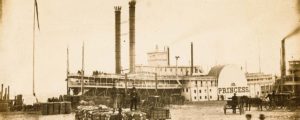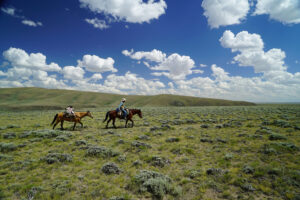The cattle might have been from Texas, the railroads from the East, but it was in Kansas after the Civil War that Longhorns met the Iron Horse to create a profitable industry for Western cattlemen and Eastern buyers and speculators. The railhead towns of Kansas found prosperity, too, though not all at the same time, for the railroads kept crawling westward, and the end-of-line town kept changing. At the same time respectable businessmen and area farmers often found fault in being in or near a “cow town.” The free-grazing Longhorns destroyed crops and brought the feared Texas fever. The spendthrift cowboys (welcomed by saloon owners and such) were only part of the package, as boomtowns attracted gamblers, prostitutes, outlaws and shady drifters. How much violence there actually was in these lively towns remains a topic of debate, but there is no doubt some notable lawmen—including the Earp brothers, the Masterson brothers and Wild Bill Hickok—earned their reputations in Kansas.
Abilene
Kansas’ first cow town boomed as the Chisholm Trail endpoint from 1867 (when drovers arrived with 35,000 head of cattle) through 1871, thanks mainly to cattle dealer Joseph G. McCoy. Strong-fisted Tom “Bear River” Smith and quick-draw James Butler “Wild Bill” Hickok served as town marshals. Farmers, businessmen and reformers ultimately united to block the cattle trade, and the railroads kept laying track.
Newton
It had one season in the bovine spotlight after the Atchison, Topeka & Santa Fe Railroad extended its main line there in July 1871. The Chisholm Trail town had almost 30 saloons, at least eight dance halls and, of course, a boot hill. The latter came in handy after the August 19, 1871, shooting affair known as the Newton Massacre (or Gunfight at Hyde Park), an exchange that dropped eight men, including five dead.
Ellsworth
Businessmen farther west in Ellsworth were eager to lure the cattle trade away from Abilene and worked with the Kansas Pacific Railroad to make it happen. The 1871 trail season showed promise, while the 1872 trail season was a rousing success. But farmers worked to stop cattle drives to this “Wickedest Town in the West,” and the star soon rose for Wichita, a new railhead to the southeast.
Wichita
The railroad arrived in “Cowtown” in 1872, and in 1873 it shipped east some 70,000 head of cattle, twice the number sent from Ellsworth. Among the lawmen who served here were Wyatt Earp and Mike and John Meagher. By 1877 restrictive farmer-imposed quarantine laws and mounting opposition to the cattle trade and its accompanying lawlessness had all but stopped the beeves in their tracks.
Dodge City
The first big year for the “Queen of the Cow Towns” was 1877, when railcars carried some 23,000 cattle east. By its early 1880s peak that annual total had risen to 75,000 head. Bat Masterson is the lawman most closely associated with Dodge, and Wyatt Earp served here before going on to greater fame in Tombstone, Arizona Territory. By 1884 farmers had fenced in much of the range, and there was a statewide quarantine against Texas cattle.
Originally published in the April 2015 issue of Wild West. To subscribe, click here.




